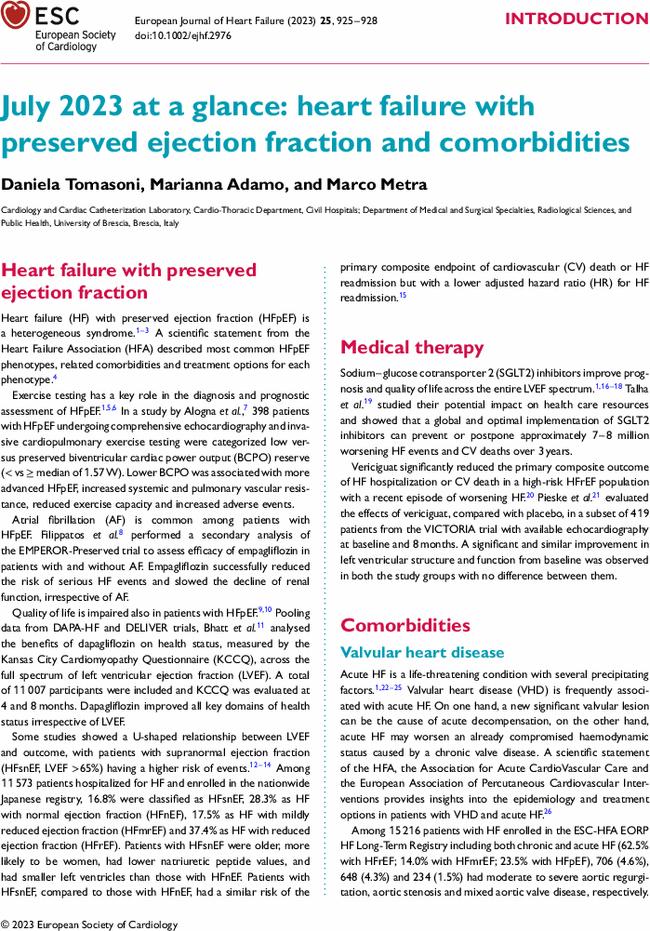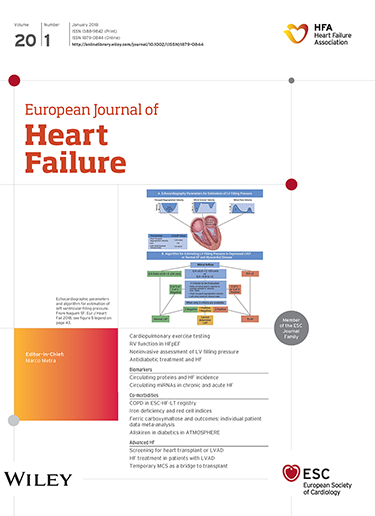July 2023 at a glance: heart failure with preserved ejection fraction and comorbidities
IF 16.9
1区 医学
Q1 CARDIAC & CARDIOVASCULAR SYSTEMS
引用次数: 0
Abstract
Heart failure (HF) with preserved ejection fraction (HFpEF) is a heterogeneous syndrome.1–3 A scientific statement from the Heart Failure Association (HFA) described most common HFpEF phenotypes, related comorbidities and treatment options for each phenotype.4 Exercise testing has a key role in the diagnosis and prognostic assessment of HFpEF.1,5,6 In a study by Alogna et al.,7 398 patients with HFpEF undergoing comprehensive echocardiography and invasive cardiopulmonary exercise testing were categorized low versus preserved biventricular cardiac power output (BCPO) reserve (< vs≥median of 1.57 W). Lower BCPO was associated with more advanced HFpEF, increased systemic and pulmonary vascular resistance, reduced exercise capacity and increased adverse events. Atrial fibrillation (AF) is common among patients with HFpEF. Filippatos et al.8 performed a secondary analysis of the EMPEROR-Preserved trial to assess efficacy of empagliflozin in patients with and without AF. Empagliflozin successfully reduced the risk of serious HF events and slowed the decline of renal function, irrespective of AF. Quality of life is impaired also in patients with HFpEF.9,10 Pooling data from DAPA-HF and DELIVER trials, Bhatt et al.11 analysed the benefits of dapagliflozin on health status, measured by the Kansas City Cardiomyopathy Questionnaire (KCCQ), across the full spectrum of left ventricular ejection fraction (LVEF). A total of 11 007 participants were included and KCCQ was evaluated at 4 and 8 months. Dapagliflozin improved all key domains of health status irrespective of LVEF. Some studies showed a U-shaped relationship between LVEF and outcome, with patients with supranormal ejection fraction (HFsnEF, LVEF >65%) having a higher risk of events.12–14 Among 11 573 patients hospitalized for HF and enrolled in the nationwide Japanese registry, 16.8% were classified as HFsnEF, 28.3% as HF with normal ejection fraction (HFnEF), 17.5% as HF with mildly reduced ejection fraction (HFmrEF) and 37.4% as HF with reduced ejection fraction (HFrEF). Patients with HFsnEF were older, more likely to be women, had lower natriuretic peptide values, and had smaller left ventricles than those with HFnEF. Patients with HFsnEF, compared to those with HFnEF, had a similar risk of the .. .. .. .. .. .. .. .. .. .. .. .. .. .. .. .. .. .. .. .. .. .. .. .. .. .. .. .. .. .. .. .. .. .. .. .. .. .. .. .. .. .. .. .. .. .. .. .. .. .. .. .. .. .. .. .. .. .. .. .. .. .. primary composite endpoint of cardiovascular (CV) death or HF readmission but with a lower adjusted hazard ratio (HR) for HF readmission.15

2023年7月概览:保留射血分数和合并症的心力衰竭
本文章由计算机程序翻译,如有差异,请以英文原文为准。
求助全文
约1分钟内获得全文
求助全文
来源期刊

European Journal of Heart Failure
医学-心血管系统
CiteScore
27.30
自引率
11.50%
发文量
365
审稿时长
1 months
期刊介绍:
European Journal of Heart Failure is an international journal dedicated to advancing knowledge in the field of heart failure management. The journal publishes reviews and editorials aimed at improving understanding, prevention, investigation, and treatment of heart failure. It covers various disciplines such as molecular and cellular biology, pathology, physiology, electrophysiology, pharmacology, clinical sciences, social sciences, and population sciences. The journal welcomes submissions of manuscripts on basic, clinical, and population sciences, as well as original contributions on nursing, care of the elderly, primary care, health economics, and other related specialist fields. It is published monthly and has a readership that includes cardiologists, emergency room physicians, intensivists, internists, general physicians, cardiac nurses, diabetologists, epidemiologists, basic scientists focusing on cardiovascular research, and those working in rehabilitation. The journal is abstracted and indexed in various databases such as Academic Search, Embase, MEDLINE/PubMed, and Science Citation Index.
 求助内容:
求助内容: 应助结果提醒方式:
应助结果提醒方式:


